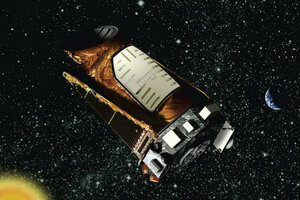Planet hunters discover two new Earth-like planets
NASA researchers have discovered eight new extrasolar planets, two of which are remarkably Earth-like. The discovery adds to a growing body of evidence that we do not live on the only habitable planet.

An artist rendering of the Kepler space telescope. Using data mined by Kepler NASA researchers discovered eight new extrasolar planets, the research team announced during a briefing Tuesday at the American Astronomical Society's winter meeting in Seattle.
NASA/AP
Mining data from NASA's premier orbiting planet hunter, Kepler, researchers have discovered eight extrasolar planets small enough to be rocky and in just the right orbits to fall within their host stars' habitable zones.
Of the eight, three are less than twice Earth's size, and two appear to be the nearest in size to Earth of any extrasolar planets yet found.
"We have significantly increased the number of these verified, small, habitable-zone planets from Kepler," said Douglas Caldwell, a member of the Kepler researcher team during a briefing Tuesday on the results at the the American Astronomical Society's winter meeting, which runs through Jan. 8 in Seattle.
For thousands of years humans have looked at the heavens and wondered if they are alone in the universe. Indeed, 25 years ago it wasn't clear how many other stars host planets. Now with more than 1,800 extrasolar planets in the books and with greater understanding of the wide range of environments in which life on Earth exists, researchers are hunting for other Earth-like planets in hopes of answering the question: Is there life elsewhere in the galaxy?
This latest discovery adds to a growing body of evidence that we do not live on the only habitable planet.
The results, which also have been accepted for publication in the Astrophysical Journal, are based on a sample of a dozen Kepler planet candidates drawn from a newly released batch of 554 candidates.
Overall, the craft identified more than 4,000 extrasolar planet candidates so far, with more expected. Kepler's four years of intense planet hunting ended unceremoniously in mid-2013 after the craft lost its ability to point with the precision needed for its task. Astronomers found additional work for the otherwise healthy craft to perform, which includes a hunt for planets much closer to home, so NASA approved a more diverse Kepler 2 mission, which is underway.
Still, it's the planet hunter whose initial flood of data is the gift that keeps on giving as researchers continue to comb through data covering more than 150,000 stars in the craft's original field of view.
The goal is to develop a census of potentially habitable planets, particularly those that orbit sun-like stars at Earth-like distances. Yet as the two planets most similar to Earth's size in this new sample show, potentially habitable planets are hardly limited to sun-like stars.
Both planets are found around red dwarf stars, which are smaller and cooler than the sun. This means their habitable zones – the range of distances that provide a planet with enough energy from the star to allow liquid water to remain stable on the planet's surface – are much closer to the star that they would be for larger, hotter stars like the sun.
One of these planets, Kepler 438b, orbits a red dwarf 475 light-years away. It's 12 percent larger than Earth and orbits its host star once every 35 days. Based on modeling results, the planet has a 70 percent likelihood of being rocky. Given uncertainties surrounding some of the the star's attributes, the planet has a 70 percent likelihood of orbiting within the star's habitable zone.
The other planet, Kepler 442b, is more distant, at 1,100 light-years away. It orbits its red dwarf once every 112 days. It's 30 percent larger than Earth, has a 97 percent chance of orbiting within the star's habitable zone, and has a 60 percent likelihood of being rocky.
Overall, the eight new planets range in in size from 1.12 to 2.73 times Earth's size and orbit their stars once every 35 to 207 days. Their stars range in age from 1.3 billion to 7.2 billion years old and have masses ranging from 54 percent to 88 percent of the sun's mass.
In addition to the eight planets the team announced, it found a ninth object that they wouldn't tag with the planet label because the uncertainties in their verification approach were a tad too large. If it is a planet, however, it too would likely fall within its star's habitable zone, although it would be the least likely of the bunch to be a rocky planet. It's nearly twice as large as Earth and orbits its star once every 148 days.
The research team couches its estimate of a planet's bulk composition in terms of probabilities because these planets are too faint and far away to verify them with a technique that would yield good estimates of their masses. Mass and size yield a better estimate of bulk composition than estimates based on size alone, the researchers acknowledge.
Despite the uncertainties, "most of these planets have a good chance of being rocky, like Earth," said Guillermo Torres of the Harvard-Smithsonian Center for Astrophysics and the lead author of the paper.
In addition to these nine objects, the researchers verified with more-accurate measurements the properties of another three extrasolar planets that others had characterized. These, too, are likely to be rocky and orbit well within their host star's habitable zones.

